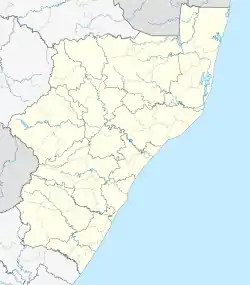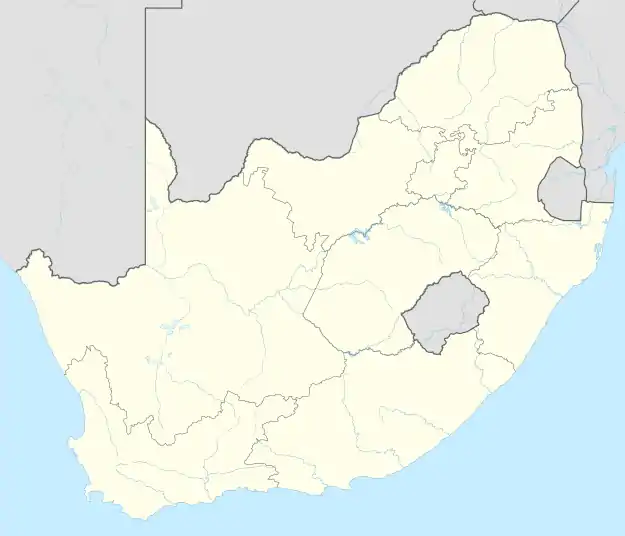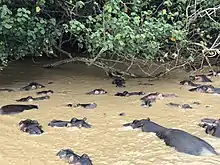St Lucia, KwaZulu-Natal
St Lucia is a settlement in Umkhanyakude District Municipality in the KwaZulu-Natal province of South Africa. The small town is mainly a hub for the Greater St Lucia Wetlands Park.[2]
St Lucia | |
|---|---|
 Main beach at St Lucia | |
 St Lucia  St Lucia | |
| Coordinates: 28.383°S 32.417°E | |
| Country | South Africa |
| Province | KwaZulu-Natal |
| District | Umkhanyakude |
| Municipality | Mtubatuba |
| Area | |
| • Total | 2.68 km2 (1.03 sq mi) |
| Population (2011)[1] | |
| • Total | 1,104 |
| • Density | 410/km2 (1,100/sq mi) |
| Racial makeup (2011) | |
| • Black African | 41.0% |
| • Coloured | 3.8% |
| • Indian/Asian | 2.1% |
| • White | 52.3% |
| • Other | 0.8% |
| First languages (2011) | |
| • Afrikaans | 38.2% |
| • English | 30.9% |
| • Zulu | 26.4% |
| • Other | 4.5% |
| Time zone | UTC+2 (SAST) |
| PO box | 3936 |
| Area code | 035 |
History
Evidence of early humans living in the caves up high in the Lebombo Mountains dating back 130,000 years ago provided scientists with clues regarding the lifestyle of these prehistoric settlers. From this cave alone some 69,000 stone implements and various human remains have been recovered. Some of these tools date back to the middle and early stone ages (130,000 to 30,000 years ago).
St Lucia was first named in 1554 as Rio dos Medos do Ouro (alternatively Rio dos Médãos do Ouro — River of the Gold Dunes)[3][4] by the survivors of the Portuguese ship São Bento.[5] At this stage, only the Tugela River mouth was known as St. Lucia. Later, in 1575, the Tugela River was named Tugela. On 13 December 1575, the day of the feast of Saint Lucy, Manuel Peresterello renamed the mouth area to Santa Lucia.
In 1822, St Lucia was proclaimed by the British as a township. In 1895, St Lucia Game Reserve, 30 km north of the town, was proclaimed. Since 1971, St Lucia Lake and the turtle beaches and coral reefs of Maputaland have been listed by the Convention on Wetlands of International Importance (Ramsar Convention). In December 1999, the park was declared a UNESCO World Heritage Site.
Animals in the park

The park is also home to about 1,200 Nile Crocodiles and almost 800 hippopotamuses. Hippos often roam the streets at night.[6]
Other animals include leopards, Greater Kudu, Black Rhinos, rich avifauna and numerous invertebrates.[7][8]
Climate
Under Köppen-Geiger climate classification system, it has a humid subtropical climate (Cfa).[9]
| Climate data for St Lucia | |||||||||||||
|---|---|---|---|---|---|---|---|---|---|---|---|---|---|
| Month | Jan | Feb | Mar | Apr | May | Jun | Jul | Aug | Sep | Oct | Nov | Dec | Year |
| Average high °C (°F) | 29.3 (84.7) |
29.2 (84.6) |
28.6 (83.5) |
26.7 (80.1) |
24.6 (76.3) |
22.8 (73.0) |
22.5 (72.5) |
23.7 (74.7) |
24.4 (75.9) |
25.1 (77.2) |
26.3 (79.3) |
28.2 (82.8) |
26.0 (78.7) |
| Daily mean °C (°F) | 25.2 (77.4) |
25.2 (77.4) |
24.5 (76.1) |
22.4 (72.3) |
19.9 (67.8) |
17.7 (63.9) |
17.5 (63.5) |
19 (66) |
20.3 (68.5) |
21.1 (70.0) |
22.5 (72.5) |
24.2 (75.6) |
21.6 (70.9) |
| Average low °C (°F) | 21.2 (70.2) |
21.2 (70.2) |
20.4 (68.7) |
18.2 (64.8) |
15.3 (59.5) |
12.6 (54.7) |
12.6 (54.7) |
14.3 (57.7) |
16.2 (61.2) |
17.2 (63.0) |
18.7 (65.7) |
20.3 (68.5) |
17.3 (63.2) |
| Average precipitation mm (inches) | 139 (5.5) |
133 (5.2) |
120 (4.7) |
100 (3.9) |
78 (3.1) |
59 (2.3) |
58 (2.3) |
59 (2.3) |
72 (2.8) |
103 (4.1) |
111 (4.4) |
97 (3.8) |
1,129 (44.4) |
| Average rainy days | 12 | 12 | 11 | 9 | 8 | 7 | 7 | 7 | 9 | 12 | 13 | 10 | 117 |
| Mean daily sunshine hours | 8 | 8 | 8 | 7 | 8 | 8 | 8 | 8 | 7 | 7 | 7 | 8 | 8 |
| Source 1: Climate-Data.org[9] | |||||||||||||
| Source 2: Weather2Travel (rainy days, sunshine)[10] | |||||||||||||
| Jan | Feb | Mar | Apr | May | Jun | Jul | Aug | Sep | Oct | Nov | Dec |
|---|---|---|---|---|---|---|---|---|---|---|---|
| 26 °C (79 °F) | 27 °C (81 °F) | 27 °C (81 °F) | 26 °C (79 °F) | 25 °C (77 °F) | 23 °C (73 °F) | 22 °C (72 °F) | 22 °C (72 °F) | 22 °C (72 °F) | 23 °C (73 °F) | 24 °C (75 °F) | 25 °C (77 °F) |
References
| Wikimedia Commons has media related to St Lucia. |
| Wikimedia Commons has media related to Beaches of St Lucia. |
- "Main Place St Lucia". Census 2011.
- "St Lucia, KwaZulu-Natal". SA Travel Directory. Retrieved 4 January 2014.
- Gomes de Brito, Bernanrdo (1735). HISTORIA TRAGICO-MARITIMA Em que se escrevem chronologicamente os Naufragios que tiveraõ as Naos de Portugal, depois que se poz em exercicio a Navegação da India, Volume 1 (PDF) (in Portuguese). Lisbon: Officina da Congregação do Oratorio. p. 109. Retrieved 11 November 2014.
- Xavier Botelho, Sebastião (1835). Memoria estatistica sobre os dominios portuguezes na Africa Oriental, Volume 1 (in Portuguese). Lisbon: Typ. de José Baptista Morando. p. 77. Retrieved 11 November 2014.
- Philip Briggs (September 2008). Greater St. Lucia Wetland Park. 30° South Publishers. p. 35. ISBN 978-0-9584891-7-1.
- "St. Lucia – a unique town where hippos roam the streets". Africa Geographic. 2019-09-05. Retrieved 2019-10-11.
- Nel, H.A., Perissinotto, R. & Taylor, R.H. 2012. Diversity of bivalve molluscs in the St Lucia Estuary, with an annotated and illustrated checklist. African Invertebrates 53 (2): 503-525."Archived copy". Archived from the original on 2012-12-24. Retrieved 2012-11-14.CS1 maint: archived copy as title (link)
- Perissinotto, R., Taylor, R.H., Carrasco, N.K. & Fox, C. 2013. Observations on the bloom-forming jellyfish Crambionella stuhlmanni (Chun, 1896) in the St Lucia Estuary, South Africa. African Invertebrates 54 (1): 161–170.
- "Climate: St. Lucia - Climate graph, Temperature graph, Climate table". Climate-Data.org. Retrieved 23 August 2013.
- "St Lucia Climate and Weather Averages, South Africa". Weather2Travel. Retrieved 23 August 2013.
.svg.png.webp)